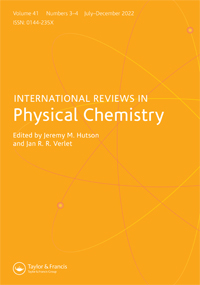The quantum nature of hydrogen
IF 2.5
2区 化学
Q3 CHEMISTRY, PHYSICAL
引用次数: 13
Abstract
ABSTRACT Hydrogen is the most abundant element. It is also the most quantum, in the sense that quantum tunnelling, quantum delocalisation, and zero-point motion can be important. For practical reasons, most computer simulations of materials have not taken such effects into account, rather they have treated nuclei as classical particles. However, thanks to methodological developments over the last few decades, nuclear quantum effects can now be treated in complex materials. Here we discuss our studies on the role nuclear quantum effects play in hydrogen containing systems. We give examples of how the quantum nature of the nuclei has a significant impact on the location of the boundaries between phases in high pressure condensed hydrogen. We show how nuclear quantum effects facilitate the dissociative adsorption of molecular hydrogen on solid surfaces and the diffusion of atomic hydrogen across surfaces. Finally, we discuss how nuclear quantum effects alter the strength and structure of hydrogen bonds, including those in DNA. Overall, these studies demonstrate that nuclear quantum effects can manifest in different, interesting, and non-intuitive ways. Whilst historically it has been difficult to know in advance what influence nuclear quantum effects will have, some of the important conceptual foundations have now started to emerge.氢的量子性质
氢是最丰富的元素。从量子隧穿、量子离域和零点运动可能很重要的意义上说,它也是最量子化的。由于实际原因,大多数材料的计算机模拟都没有考虑到这种效应,而是把原子核当作经典粒子来对待。然而,由于过去几十年方法的发展,现在可以在复杂材料中处理核量子效应。本文讨论了核量子效应在含氢体系中的作用。我们给出了原子核的量子性质如何对高压凝聚氢中相间边界的位置产生重大影响的例子。我们展示了核量子效应如何促进分子氢在固体表面上的解离吸附和原子氢在表面上的扩散。最后,我们讨论了核量子效应如何改变氢键的强度和结构,包括DNA中的氢键。总的来说,这些研究表明,核量子效应可以以不同的、有趣的、非直觉的方式表现出来。虽然从历史上看,很难事先知道核量子效应会产生什么影响,但一些重要的概念基础现在已经开始出现。
本文章由计算机程序翻译,如有差异,请以英文原文为准。
求助全文
约1分钟内获得全文
求助全文
来源期刊
CiteScore
14.20
自引率
1.60%
发文量
5
审稿时长
1 months
期刊介绍:
International Reviews in Physical Chemistry publishes review articles describing frontier research areas in physical chemistry. Internationally renowned scientists describe their own research in the wider context of the field. The articles are of interest not only to specialists but also to those wishing to read general and authoritative accounts of recent developments in physical chemistry, chemical physics and theoretical chemistry. The journal appeals to research workers, lecturers and research students alike.

 求助内容:
求助内容: 应助结果提醒方式:
应助结果提醒方式:


